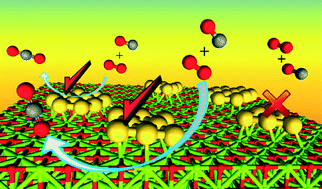Dec 10 2014
Researchers belonging to the University of Pittsburgh, Swanson School of Engineering, have led a study to explore the functioning of catalysts at the nanoscale level using novel computer simulations.
 Au has been widely used as jewelry since ancient times due to its bulk, chemically inert properties. During the last three decades, nanoscale Au has attracted remarkable attention and has been shown to be an exceptional catalyst, especially for oxidation reactions. Herein, we elucidate a puzzle in catalysis by using multiscale computational modeling: the experimentally observed “magic number” CO oxidation catalytic behavior of sub-nanoscale Au clusters. Our results demonstrate that support effects (cluster charging), symmetry-induced electronic effects on the clusters, catalyst reconstruction, competing chemical pathways and formation of carbonate contribute to the marked differences in the observed catalytic behavior of Aun− clusters with n = 6, 8 and 10 atoms. This is the first demonstration of multiscale simulations on sub-nanoscale catalysts unraveling the magic number activity for the CO oxidation reaction on Au.
Au has been widely used as jewelry since ancient times due to its bulk, chemically inert properties. During the last three decades, nanoscale Au has attracted remarkable attention and has been shown to be an exceptional catalyst, especially for oxidation reactions. Herein, we elucidate a puzzle in catalysis by using multiscale computational modeling: the experimentally observed “magic number” CO oxidation catalytic behavior of sub-nanoscale Au clusters. Our results demonstrate that support effects (cluster charging), symmetry-induced electronic effects on the clusters, catalyst reconstruction, competing chemical pathways and formation of carbonate contribute to the marked differences in the observed catalytic behavior of Aun− clusters with n = 6, 8 and 10 atoms. This is the first demonstration of multiscale simulations on sub-nanoscale catalysts unraveling the magic number activity for the CO oxidation reaction on Au.
In chemical reactions, platinum and other such precious elements function well as catalysts. However, they could be costly and the process may require large quantities of the material. It may be possible to design inexpensive catalysts from gold that also demonstrate better efficiency, using computational modeling at the subnanoscale level.
"Gold has been widely used as jewelry since ancient times because it does not corrode and keeps its bright yellow color," Dr. Giannis Mpourmpakis, an assistant professor of Chemical and Petroleum Engineering at the Swanson School, and the principal investigator of the study said. "However, subnanoscale catalysts consisting of only a few gold atoms show very rich and difficult to understand chemistry and finding the right composition requires trial and error experimentation in the lab. For example, a catalyst that consists of eight gold atoms can be extremely active for oxidation reactions, whereas the catalyst of six gold atoms is not active at all. This behavior has puzzled many researchers over the last decade."
The new methods of computational modeling help reduce the time and costs involved in lab experimentation and enable more accurate predictions of the method to design better catalysts using very little amount of the material, which would lead to reduction in cost, stated Dr. Mpourmpakis.
A characteristic reaction using platinum catalysts would need thousands of atoms of this metal. However, when gold is used, the process may require less than ten atoms. This process holds great potential for applications in environment and energy fields. For example, catalytic reactions take place when carbon monoxide and water are used to produce hydrogen, and when carbon monoxide is converted into carbon dioxide in the exhaust of vehicles.
Dr. Michail Stamatakis, a lecturer of Chemical Engineering at the University College London, and a co-author of this study, highlighted that "our study unravels a high degree of complexity in the catalytic behavior of small gold clusters. We were very excited to reveal many competing physicochemical phenomena on the catalyst that give rise to the activity of specific catalyst sizes."
The computational research that Dr. Mpourmpakis had conducted along with others, aims to formulate a better modeling process with more efficiency and lower cost to speed up the design of catalysts.
"In lab experiments you can't see in detail the physical and chemical properties that affect the catalytic activity, but with computations you can virtually "see" them and reduce experimental trial and error," Dr. Mpourmpakis explained. "By designing an effective catalyst with only a few atoms of metal, we can create a more sustainable method to improve chemical reactions across many industries, especially throughout the energy sector."
Dionisios Vlachos, a professor of Chemical and Biomolecular engineering at the University of Delaware, and Nima Nikbin and Natalie Austin, who are student researchers, are other co-authors of this study.
The Royal Society of Chemistry has featured this study titled "Catalysis at the sub-nanoscale: complex CO oxidation chemistry on a few Au atoms" (DOI: 10.1039/C4CY01295J) in its January issue of Catalysis Science & Technology as the cover article.